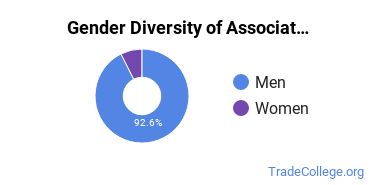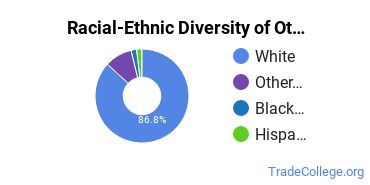Find Trade Colleges
Associate Degrees in Other Precision Production
Education Levels of Other Precision Production Majors
During the 2021-2022 academic year, 42 students earned their associate degree in other precision production. This makes it the 154th most popular associate degree program in the country.
The following table shows the number of diplomas awarded in other precision production at each degree level.
| Education Level | Number of Grads |
|---|---|
| Associate Degree | 42 |
| Undergraduate Certificate | 16 |
| Basic Certificate | 9 |
Earnings of Other Precision Production Majors With Associate Degrees
At this time, we do not have the data to estimate the median earnings for this class of people.
Student Debt
The data on debt ranges for other precision production majors who have their associate degree is not available.
Student Diversity
More men than women pursue associate degrees in other precision production. About 90.5% of graduates in this field are male.
| Gender | Number of Grads |
|---|---|
| Men | 38 |
| Women | 4 |

The racial-ethnic distribution of other precision production associate degree students is as follows:
| Race/Ethnicity | Number of Grads |
|---|---|
| Asian | 0 |
| Black or African American | 0 |
| Hispanic or Latino | 2 |
| White | 36 |
| International Students | 0 |
| Other Races/Ethnicities | 4 |

Most Popular Other Precision Production Programs for Associate Degrees
There are 12 colleges that offer an associate degree in other precision production. Learn more about the most popular 12 below:
Salem Community College tops the list of the most popular school in the U.S. for other precision production majors who are seeking their associate degree. Roughly 800 attend the school each year. The other precision production program at Salem Community College awarded 20 associate degrees during the 2021-2022 school year. About 25% of this group were women, and 38% were students from an underrepresented racial-ethnic group.
The 2nd most popular school in the country for other precision production majors who are seeking their associate degree is Washtenaw Community College. Each year, around 10,800 students seeking various degrees attend the university. The other precision production program at Washtenaw Community College awarded 19 associate degrees during the 2021-2022 school year. Around 10% of these students were from an underrepresented racial-ethnic group, and 5% were women.
Lake Michigan College comes in at #3 on our list of the most popular colleges offering associate degrees in other precision production. Roughly 2,700 attend the school each year. During the 2021-2022 academic year, 9 people received their associate degree in other precision production from LMC.
Northern Wyoming Community College District is the 5th most popular school in the nation for students seeking an associate degree in other precision production. The other precision production program at Northern Wyoming Community College District awarded 2 associate degrees during the 2021-2022 school year.
Truckee Meadows Community College comes in at #6 on our list of the most popular colleges offering associate degrees in other precision production. During the 2021-2022 academic year, 1 people received their associate degree in other precision production from Truckee Meadows Community College.
Mineral Area College comes in at #7 on our list of the most popular colleges offering associate degrees in other precision production. The other precision production program at Mineral Area College awarded 0 associate degrees during the 2021-2022 school year.
St Charles Community College comes in at #7 on our list of the most popular colleges offering associate degrees in other precision production. The other precision production program at St Charles Community College awarded 0 associate degrees during the 2021-2022 school year.
Explore Major by State
Alabama
Arkansas
Connecticut
Florida
Idaho
Iowa
Louisiana
Massachusetts
Mississippi
Nebraska
New Jersey
North Carolina
Oklahoma
Rhode Island
Tennessee
Vermont
West Virginia
References
*The racial-ethnic minority student count is calculated by taking the total number of students and subtracting white students, international students, and students whose race/ethnicity was unknown. This number is then divided by the total number of students at the school to obtain the percentage of racial-ethnic minorities.
- College Factual
- National Center for Education Statistics
- O*NET Online
- Bureau of Labor Statistics
- Image Credit: By Mixabest under License
More about our data sources and methodologies.

